I've got a little white crested chocolate (dun I suppose, obviously not true chocolate
 ) Polish roo that has some leaky red in his feathers. I'm confused! Please help my genetics-challenged self to understand what happened here!
) Polish roo that has some leaky red in his feathers. I'm confused! Please help my genetics-challenged self to understand what happened here!
 It's my understanding that if you've got lighter colors leaking through a dark bird, that there is a lack of the melanizing gene that, basically, covers the light color and keeps the bird the dark (correct) color? Correct (or not--please explain)?? So...if this is the case, what might be in the background of my little chocolate bird that was RED? I've had leaky silver in black and blue Ameraucanas pop up before, and that kind of makes sense, but why would red show up in chocolate?
It's my understanding that if you've got lighter colors leaking through a dark bird, that there is a lack of the melanizing gene that, basically, covers the light color and keeps the bird the dark (correct) color? Correct (or not--please explain)?? So...if this is the case, what might be in the background of my little chocolate bird that was RED? I've had leaky silver in black and blue Ameraucanas pop up before, and that kind of makes sense, but why would red show up in chocolate?
I'm bummed, because he seems to have nice type and I had khaki plans!
 I got a hold of another chocolate roo this weekend, but his type is not as nice as this one.
I got a hold of another chocolate roo this weekend, but his type is not as nice as this one.
The roo in question was the result of a chocolate cuckoo roo over a black hen. He's only a few months old. Pics below:




I'm bummed, because he seems to have nice type and I had khaki plans!

The roo in question was the result of a chocolate cuckoo roo over a black hen. He's only a few months old. Pics below:







